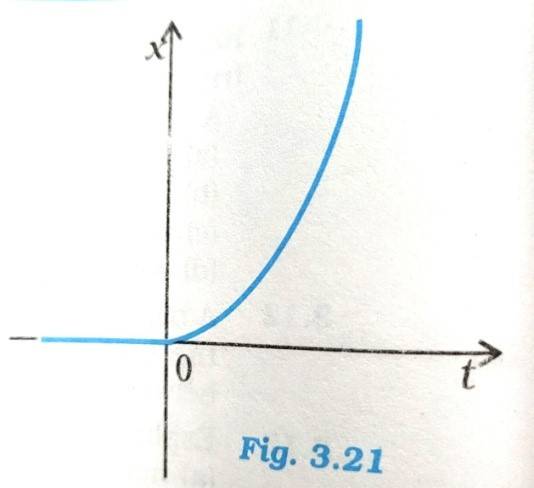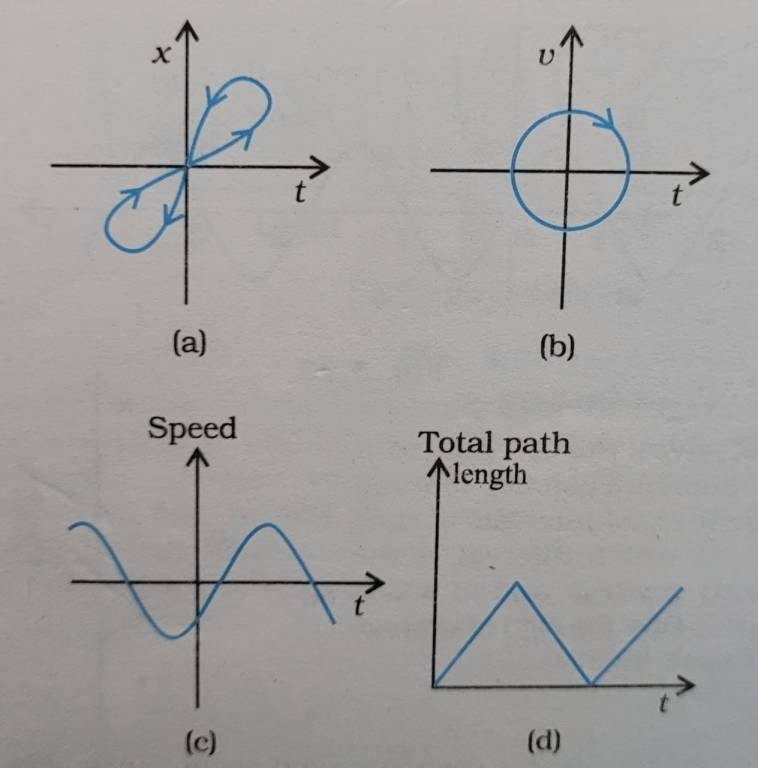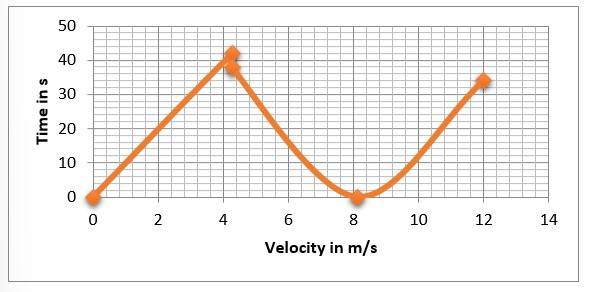physics ncert solutions class 11th
Get insights from 952 questions on physics ncert solutions class 11th, answered by students, alumni, and experts. You may also ask and answer any question you like about physics ncert solutions class 11th
Follow Ask QuestionQuestions
Discussions
Active Users
Followers
New answer posted
5 months agoContributor-Level 10
3.18 Speed of the police van = 30 kmph = 8.33 m/s
Speed of the thief's car = 192 kmph = 53.33 m/s
The muzzle speed of the bullet = 150 m/s
Speed of the bullet = speed of the police van + muzzle speed of the bullet = 8.33 + 150m/s = 158.33 m/s
The relative velocity of the bullet = speed of the bullet – speed of the thief's car = 158.33 – 53.33 m/s = 105 m/s
New answer posted
5 months agoContributor-Level 10
3.17 For t<0, we cannot say that the particle moved in a straight line and for t>0 on a parabolic path as the x-t graph does not indicate. Instead, this x-t graph denotes a particle is dropped from a height at t=0
New answer posted
5 months agoContributor-Level 10
3.16
(a) Figure (a) shows two positions at the same time, which is not possible for a one-dimensional motion
(b) A particle cannot have velocity in two directions at the same time in one-dimensional motion
(c) The graph shows negative speed, which is not possible because speed is always positive
(d) Total path length decreases, which is not possible for a one – dimensional motion
New answer posted
5 months agoContributor-Level 10
3.15 Instantaneous speed and velocity are applicable for a small interval of time because the magnitude of the displacement is effectively equal to the distance travelled by the particle.
New answer posted
5 months agoContributor-Level 10
3.14
The distance from home to market = 2.5 km = 2500 m
The speed of the walking while going = 5 kmph = 1.388 m/s
The speed of walking back from market to home = 7.5 kmph = 2.083 m/s
(a) Magnitude of the average velocity = Displacement / time = 0, since the total displacement is zero.
(b)
i. Time taken to reach the market = distance / onward speed = 2500/1.388 = 1801 s = 30 minutes. So the average speed over 0 – 30 min is 5 kmph
ii. Time taken to reach back home = 2500 / 2.083 = 20 minutes. So the average speed = total distance covered / total time taken = (2500 +2500)/ (30 +20) m/min = 100 m/min = 6 kmph
iii. Average speed ove
New answer posted
5 months agoContributor-Level 10
3.13
(a) Let us take the example of football world cup 2022. During Argentina match, Di Mario (A) passed the ball to Messi (B). Messi instantly passed the ball to Di Mario. Now the magnitude of displacement of the ball is 0 as the ball returns to Di Mario at the initial position. But the total length covered by the ball is AB + BA = 2AB. Hence total length covered by the particle (the ball) is more than the magnitude.
(b) If t is the time taken to cover the entire distance, the magnitude of the average velocity of the ball over time interval t = Magnitude of displacement / t = 0 / t = 0
The average speed of the ball = Total lengt
New answer posted
5 months agoContributor-Level 10
Given data:
Initial height, h = 90 m
Acceleration due to gravity, g = 9.8 ms2
Speed lost at each collision = 1/10 of its speed
time interval to be considered: 0 to 12 secs.
Step 1: Time to fall from 90 m
h = ½ gt2 ⇒ 90 = 21 * 9.8 * t2 ⇒ t2 = 9.8180 ≈ 18.37 ⇒ t ≈ 4.29 seconds
Step 2: Speed before first impact
v = gt = 9.8 * 4.29 ≈ 42 m/s
After hitting the floor with 42 m/s, ball rebound with;
vrebound = 0.9*42 = 37.8m/s
Step 3:
Max height after rebound:
Use:
t = g / v = 37.8 / 9.8 ≈ 3.86s
Again, the b
New answer posted
5 months agoContributor-Level 10
3.11
(a) True – zero speed may have a non zero instantaneous non-zero acceleration
(b) False – zero speed will always make zero velocity
(c) True – constant speed will have zero acceleration
(d) False – If the positive value of acceleration is in the direction of its motion then it can speed up
New answer posted
5 months agoContributor-Level 10
3.10
(a) The direction of the acceleration is downward during the upward motion of the ball because the acceleration is due to gravity. Gravity always pulls the object toward the centre of the earth.
(b) Velocity: At the peak the velocity is zero because the ball momentarily stops before falling downwards.
Acceleration: g = 9.8 ms–2
(c) If we consider the highest point x = 0 m, t= 0 s,
During upward motion of the ball before it reaches the maximum height, x = +ve, velocity = -ve, acceleration = +ve. During downward motion, x = +ve, velocity = +ve, acceleration = +ve
(d) At the highest point, final velocity v = 0, initial vel
New answer posted
5 months agoContributor-Level 10
3.9 Cycling speed = 20 kmph
Let as assume speed of the bus is
The relative velocity of the buses in the direction of motion of the cyclist = -
Buses go past him every 18 mins = 18/60h = 0.3h
Distance covered = ( ) * 0.3
Since the buses leave every T minutes, ( ) * 0.3 = * (T/60) ……(1)
The relative velocity of the buses in the opposite direction of the cyclist = +
Buses go past him in the opposite direction = every 6 m = 6/60 h
Distance covered = ( + ) * 1/10
Since the buses leave every T minute, we get ( + ) * 1/10
Taking an Exam? Selecting a College?
Get authentic answers from experts, students and alumni that you won't find anywhere else
Sign Up on ShikshaOn Shiksha, get access to
- 65k Colleges
- 1.2k Exams
- 682k Reviews
- 1800k Answers



